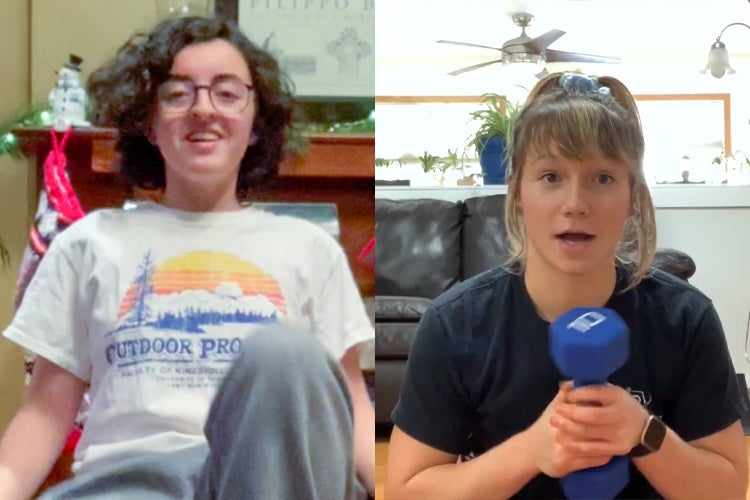U of T students help keep youth, seniors and special needs groups active during lockdown
When Ontario went into its second COVID-19 lockdown last fall, Premier Doug Ford emphasized that heading out for exercise would be encouraged since it’s essential for maintaining physical and mental health.
So, students of the University of Toronto’s Faculty of Kinesiology & Physical Education (KPE) got to work to help get Torontonians moving.
Under the faculty’s KINections program, students filmed themselves performing movement breaks called Movement Minutes for a variety of community partners, including schools, youth groups, children with special needs and seniors’ homes.
“Making these videos provided students with an opportunity to connect with the communities around them, share their knowledge and bring some positivity in these strange times,” says Barb Brophey, senior athletic instructor at KPE who’s been helping coordinate KINections’ community engagement initiatives.
Students could either suggest who they wanted to work with or were matched with a community partner through KINections. Mandy Chung, a second-year kinesiology student, made a video for the 5th Unionville Scouts Group, which she once belonged to. The video will be used by the scout’s youngest members, Beavers and Cubs.
“Knowing that the pandemic has affected us all mentally, socially and physically, I wanted to help support the community somehow,” says Chung. “I thought making a Movement Minute video was an excellent opportunity to engage kids in physical activity and maybe put a smile on their faces.”
Sara Sutherland and Anna Khouzam, both in their third year of kinesiology, made videos for Holland Bloorview Kids Rehabilitation Hospital to complement their Fit & Flex program, a recreation group program for clients of the hospital to improve their function, motor skills and promote overall wellness.
“Clients of the program typically have two six-week blocks on and two six-week off blocks during the year, so the Movement Minute videos have been an excellent resource for those who have been on an off-block,” says Darlene Espinosa, an occupational therapy and physiotherapy assistant in the child development program at Holland Bloorview. “It has given them an opportunity to follow along familiar exercises with new and inviting faces.”
The benefits of the collaboration extend to clients beyond the Fit & Flex program, adds Espinosa. Typically, all children at Holland Bloorview get paper copies for a home exercise program, but now they will have a bank of videos they can access when they need a movement break.
“I decided to get involved in the Movement Minute initiative because I wanted to give back during these crazy, uncertain times,” says Sutherland, who submitted 12 videos to Holland Bloorview. “It’s been incredibly rewarding and I am so grateful for the opportunity to connect with others and help them be physically active in the safety of their homes.”
Khouzam says she enjoyed the experience so much that she is now working on a video for the Clinton Street Junior Public School’s classes for children with development delays.

Anna Khouzam (left) and Sara Sutherland (right) are both in their third year in KPE and made several videos for the Holland Bloorview Kids Rehabilitation Hospital’s Fit & Flex program.
Linda Trinh, an assistant professor at KPE, is embarking on a similar project in her KPE330 course that will count toward students’ grades.
“We have partnered with four community organizations [that] will provide an overview of their mission, what their needs are, as well as the outcomes that are desired from a physical activity intervention,” says Trinh. “As part of the course, the students will be tasked with designing physical activity interventions to meet these priorities.”
The course tries to partner with different organizations every year and choose organizations that speak to the diversity of the Canadian population, including groups that may struggle to adopt and maintain physical activity, according to Trinh.
“For example, this year we partnered with a multicultural community centre for newcomers to Canada, older adults, pediatric rehabilitation and long-term care homes,” she says.
The students will be allowed to choose a community partner to work with while designing a remote physical activity. “I find that students are most excited about the project when they get to work with an organization they are truly passionate about,” says Trinh.
She adds that the pandemic has created challenges to becoming physically active or maintaining physical activity.
“Engaging in physical activity is more important than ever for physical and mental health,” she says.
“Some of our community partners have ceased their physical activity programs and we are trying to get the students to come up with creative solutions to move these programs online for broad reach.”

